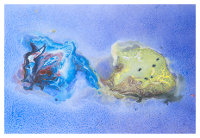Speaker
Description
Summary
The Nambu--Jona-Lasinio model [1] is a simple, yet powerful, tool in the study of strongly interacting matter in the low energy nonperturbative regime. The inclusion of flavor mixing through the 't Hooft determinant [2] breaks the unwanted axial symmetry.
The possibility of nonuniform phases characterized by a spatially periodic chiral condensate has been the subject of intense investigation (for a recent review see for instance [3]).
The results pertaining the inclusion of the strange quark in these nonuniform phases, which is of great importance for a realistic description of dense quark matter, was done for the first time by the authors in [4]. There it was shown that flavor mixing of the strange and light quarks allows for existence of a much larger baryonic chemical potential window for the formation of a stable dual chiral-wave state as compared to the two-flavor case. In addition, strangeness catalyzes the occurrence of a new branch of nonhomogeneous solutions at moderate densities. The modulation of the chiral condensates in the light quark sector is taken to be one dimensional, while strangeness is embedded as a homogeneous condensate in the spontaneously broken phase of chiral symmetry. A finite current quark mass for the strange quark is incorporated, while the up and down current masses are set to zero. In that case the modulation considered provides an exact analytic solution for the
system. Despite the simplicity of the ansatz, the emerging phase diagram displays a very
rich structure.
[1] Y. Nambu and G. Jona-Lasinio, Phys. Rev. 122, 345 (1961); Y. Nambu and G. Jona-Lasinio, Phys. Rev. 124, 246 (1961); V. G. Vaks and A. I. Larkin., Zh. Éksp. Teor. Fiz. 40, 282
(1961).[Sov. Phys. JETP 13, 192 (1961)].
[2] G. ’ t Hooft, Phys. Rev. D 14, 3432 (1976); V. Bernard, R. L. Jaffe, and U. G. Meissner, Phys. Lett. B198, 92 (1987); V. Bernard, R. L. Jaffe, and U. G. Meissner, Nucl. Phys. B308, 753 (1988); H. Reinhardt and R. Alkofer, Phys. Lett. B 207, 482 (1988).
[3] Michael Buballa and Stefano Carignano, arXiv:1406.1367 [hep-ph]
[4] J. Moreira, B. Hiller, W. Broniowski, A.A. Osipov, A.H. Blin, Phys.Rev. D89 (2014) 036009 arXiv:1312.4942 [hep-ph]
